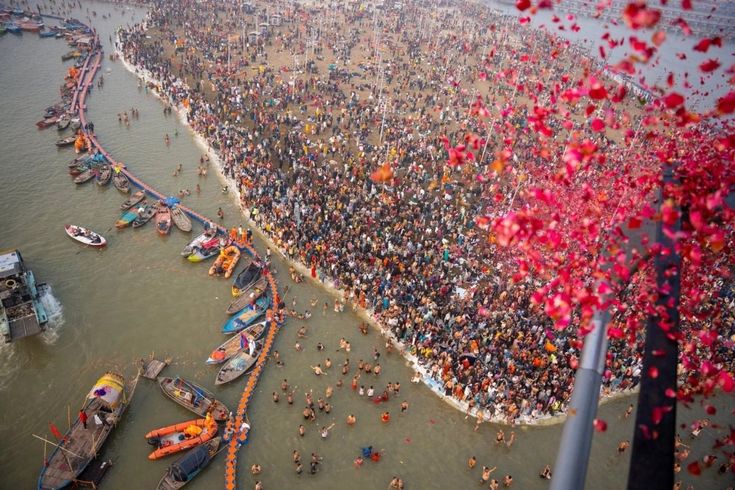The Mahakumbh Mela, a colossal pilgrimage and festival, is a spectacle of faith, culture, and humanity that draws millions to the confluence of sacred rivers. This awe-inspiring event, held every 12 years, is more than just a gathering; it’s a profound spiritual experience steeped in ancient traditions and captivating mysteries. This blog post unveils 15 fascinating facts about the Mahakumbh, offering a glimpse into the heart of this extraordinary phenomenon.
What Makes the Mahakumbh So Extraordinary?
The Mahakumbh is a unique event, unparalleled in its scale and significance. Its blend of religious devotion, cultural expression, and sheer human magnitude makes it a truly remarkable phenomenon. Understanding the facts behind the Mahakumbh enhances our appreciation for its complexity and its profound impact on individuals and society.
15 Fascinating Facts About the Mahakumbh:
- A Gathering of Epic Proportions: The Mahakumbh is considered the largest peaceful gathering of humans on Earth. Millions of pilgrims converge at the confluence of the Ganges, Yamuna, and the mythical Saraswati rivers (in the case of Prayagraj). The sheer scale of the event is mind-boggling. (Keywords: Mahakumbh, largest gathering, pilgrimage, scale)
- Astrological Significance: The timing of the Mahakumbh is determined by complex astrological calculations, specifically the alignment of Jupiter, the Sun, and other celestial bodies in specific zodiac signs. This astrological significance adds another layer of mystique to the event. (Keywords: astrological significance, Jupiter, Sun, celestial bodies)
- Rotating Locations: The Mahakumbh Mela rotates between four different locations: Haridwar, Prayagraj (Allahabad), Nashik, and Ujjain. Each location holds its own unique spiritual significance and historical connections. (Keywords: rotating locations, Haridwar, Prayagraj, Nashik, Ujjain)
- A 12-Year Cycle: The Mahakumbh occurs every 12 years, marking the completion of a full cycle of Jupiter’s transit through the zodiac. This 12-year cycle is deeply rooted in Hindu cosmology and adds to the anticipation surrounding the event. (Keywords: 12-year cycle, Jupiter, zodiac, Hindu cosmology)
- The Sangam: A Sacred Confluence: The heart of the Mahakumbh is the sangam, the confluence of the holy rivers. Bathing in the sangam during the auspicious time of the Mahakumbh is believed to cleanse one’s sins and bring spiritual liberation. (Keywords: sangam, confluence, Ganges, Yamuna, Saraswati, purification)
- Spiritual Significance: The Mahakumbh Snan (bathing ritual) is a central act of faith. Devotees believe that the waters possess a purifying power, washing away karmas and facilitating spiritual growth. (Keywords: spiritual significance, Mahakumbh Snan, bathing ritual, karma)
- A Tapestry of Traditions: The Mahakumbh showcases a rich diversity of Hindu traditions, rituals, and practices. It’s a melting pot of different sects, philosophies, and cultural expressions. (Keywords: Hindu traditions, rituals, cultural expressions)
- Naga Sadhus: The Ascetic Warriors: The Naga Sadhus, known for their extreme asceticism and their participation in the shahi snan (royal bath), are a prominent feature of the Mahakumbh. Their presence adds a unique and often awe-inspiring dimension to the event. (Keywords: Naga Sadhus, asceticism, shahi snan, royal bath)
- Akharas: The Religious Orders: Various akharas (religious orders) participate in the Mahakumbh, each with its own traditions and practices. The shahi snan is a significant event where the akharas proceed in elaborate processions to bathe in the sangam. (Keywords: akharas, religious orders, shahi snan, processions)
- The Kumbh Mela’s Ancient Roots: The Kumbh Mela, including the Mahakumbh, has ancient roots, dating back to Hindu mythology and mentioned in ancient scriptures. Its historical significance adds to its mystique and its connection to India’s spiritual heritage. (Keywords: ancient roots, Hindu mythology, scriptures, historical significance)
- A City of Tents: During the Mahakumbh, a massive temporary city of tents springs up along the riverbanks to accommodate the millions of pilgrims. This tent city is a marvel of logistics and organization. (Keywords: tent city, temporary city, logistics, organization)
- A Cultural Melting Pot: The Mahakumbh brings together people from all walks of life, transcending caste, class, and regional barriers. It’s a celebration of India’s diverse cultural landscape. (Keywords: cultural melting pot, diversity, social cohesion)
- Media Attention: The Mahakumbh attracts significant media attention from around the world, showcasing this extraordinary event to a global audience. This media coverage also promotes tourism and cultural exchange. (Keywords: media attention, tourism, cultural exchange)
- Challenges and Management: Organizing an event of this magnitude presents numerous challenges, including crowd management, sanitation, and security. The scale of the logistics involved is immense. (Keywords: challenges, crowd management, sanitation, security, logistics)
- A Spiritual Journey: For millions of devotees, the Mahakumbh is a deeply personal and transformative spiritual journey. It’s a chance to connect with their faith, purify their souls, and experience the profound spiritual energy of this unique event. (Keywords: spiritual journey, transformation, faith, personal growth)
The Mahakumbh is more than just a festival; it’s a phenomenon that embodies the rich tapestry of Indian culture, spirituality, and tradition. These fascinating facts offer a glimpse into the heart of this extraordinary event, revealing its complexity, its significance, and its enduring power to inspire and transform.
